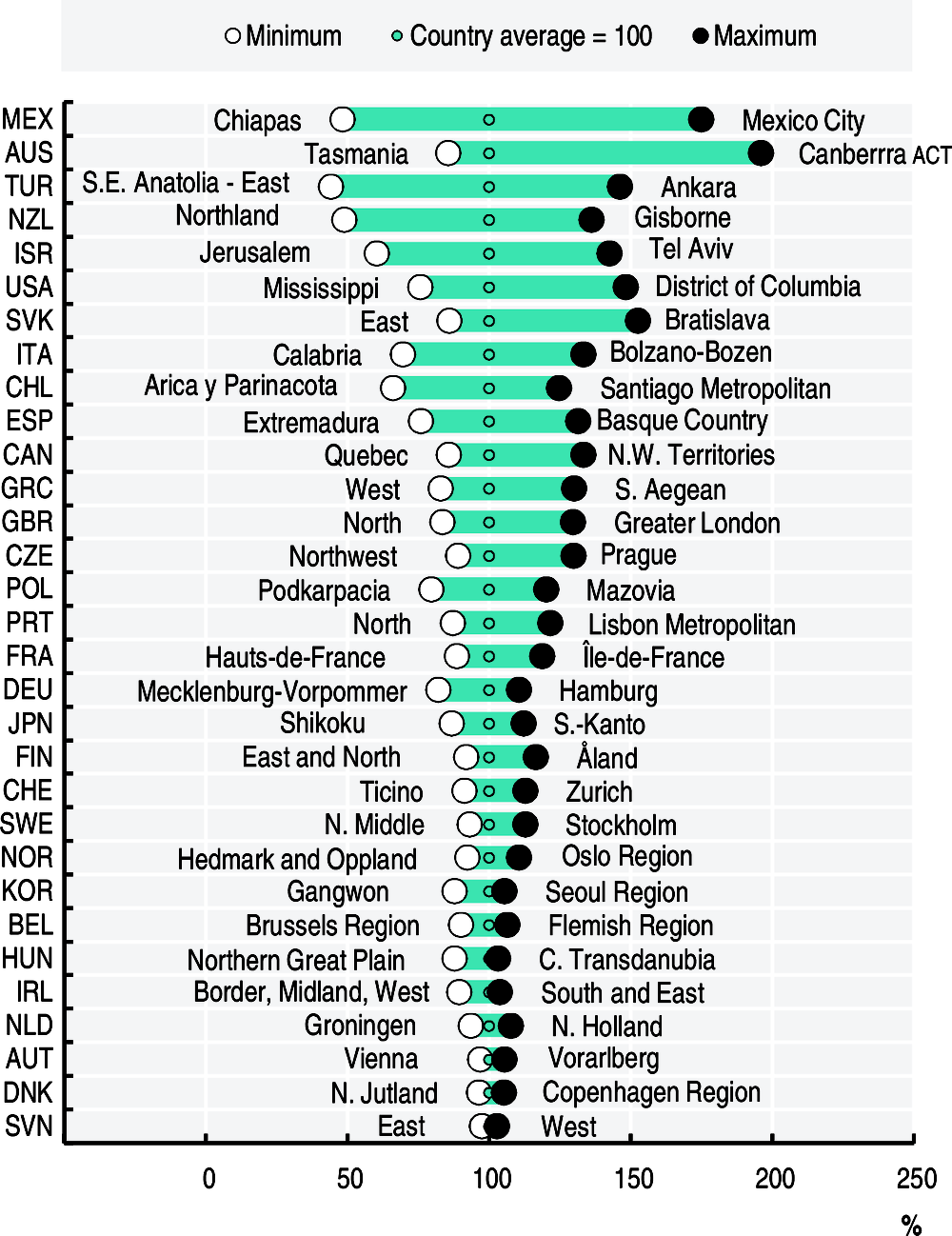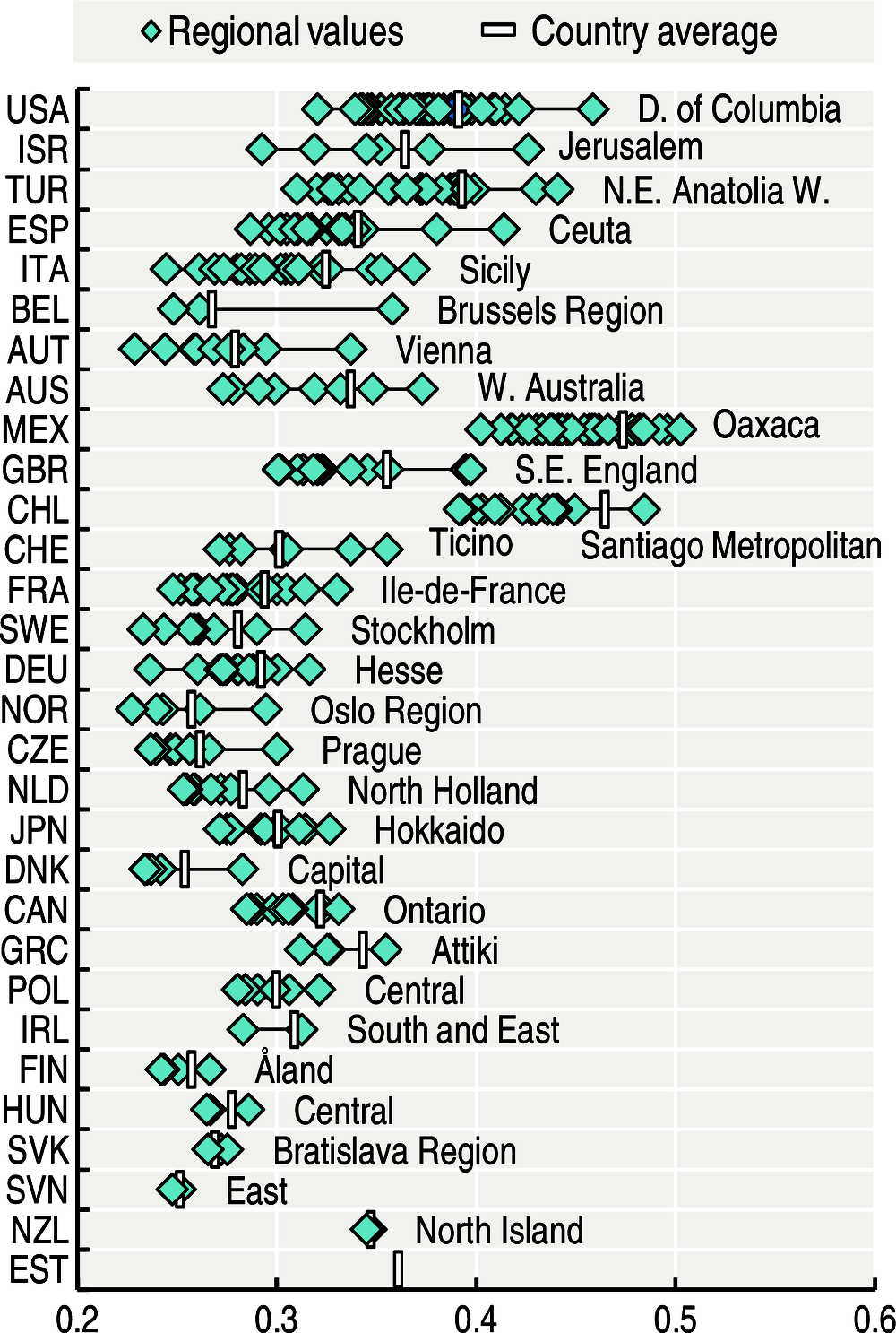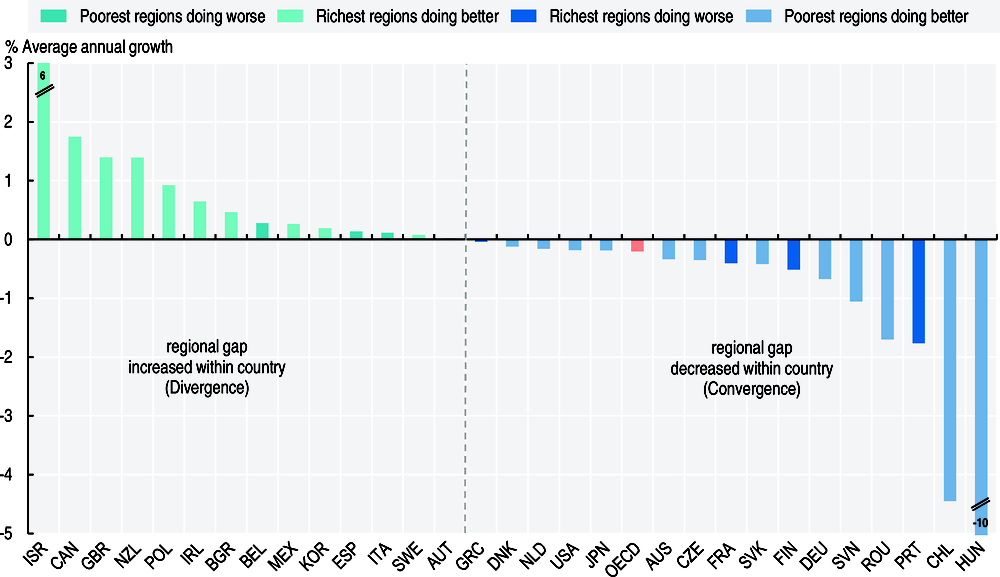Household income
In countries with rising disparities in household income, those disparities were mainly driven by faster income per capita growth in the most affluent regions.
Disposable income measures the capacity of households (or individuals) to consume goods and services. As such, it is a better indicator of material well-being of citizens than gross domestic product (GDP) per inhabitant. Regions specialised in natural resources production or regions that host the headquarters of large firms and that employ many workers living in other regions may display a very high GDP per capita, which does not necessarily translate into correspondingly high income of their inhabitants.
Disparities in regional disposable income per capita within countries are generally smaller than those in terms of GDP per capita. Even so, per capita disposable income in Mexico City (Federal District, Mexico), Canberra (Capital Territory, Australia), Ankara (Turkey), Gisborne Region (New Zealand) and Tel Aviv District (Israel), was in 2016 more than two times higher than in Chiapas, Tasmania, South-eastern Anatolia, East/ Northland Region and Jerusalem District, respectively. Similarly, in Australia, Mexico, Slovak Republic and the United States, inhabitants in the top income region had on average income that were over 50% higher than the national average (Figure 2.5).
In roughly half of OECD countries, income disparities between the richest and poorest regions further increased during the last decade, this increase was particularly large in Israel, Canada and the United Kingdom where the ratio of income per capita between the top 10% and the bottom 10% of regions grew by more than 1.4% on average per year over the period 2011-16 (Figure 2.7). However, disparities decreased in various other countries, most notably in Hungary, Chile and Portugal. In countries with decreasing regional disparities, income convergence was predominantly driven by larger growth in the bottom regions. Analogously, regional divergence in income was generally driven by above average increases in disposable income in the richest regions, with some exception like Belgium, Spain and Italy (Figure 2.7).
Disposable income of private households is derived from the balance of primary income by adding all current transfers from the government, except social transfers in kind, and subtracting current transfers from the households such as income taxes, regular taxes on wealth, regular inter-household cash transfers and social contributions. The primary income of private households is defined as the income generated directly from market transactions, i.e. the purchase and sale of goods and services.
Regional disposable household income is expressed in USD purchasing power parities (PPP) at constant prices (year 2010).
The Gini index is a measure of inequality which takes on values between 0 and 1, with zero interpreted as perfectly equal distribution. Here the Gini index is applied to the disposable household income of individuals living in the same region. See Annex C for further details.
Differences in income are not only observed across regions, but also for households living in the same region. Levels of income inequality within regions differ, and these differences are particularly high in all large OECD countries as well as in some small countries with a dominant urban centre. For example, the difference between the Gini coefficients of the District of Columbia and the state of Utah in the United States (around 0.14) is of the same magnitude of the difference in the Gini coefficient between Mexico and the OECD average (Figure 2.6).
Source
OECD (2018), OECD Regional Statistics (database), https://doi.org/10.1787/region-data-en.
OECD (2016), “Detailed National Accounts, SNA 2008 (or SNA 1993): Final consumption expenditure of households”, OECD National Accounts Statistics (database), https://doi.org/10.1787/data-00005-en.
See Annex B for data sources and country-related metadata.
Reference years and territorial level
2011-16; TL2.
Regional data are not available in Iceland, Luxembourg, Switzerland and Turkey.
Further information
OECD Regional Well-Being: www.oecdregionalwellbeing.org.
Figure notes
2.5-2.7: Last available year: 2016; Canada, Finland, France, France, France, Germany, Hungary, Ireland, Japan, Mexico, New Zealand, Norway, Poland, Portugal, Slovenia, Spain and Turkey, 2015; Belgium and Switzerland, 2014; Italy and Sweden, 2013; Chile 2012.
2.7: First available year: Chile, Ireland, Israel, and Slovak Republic 1996; United Kingdom 1997; New Zealand 1998; Slovenia 1999; Austria, Denmark, Finland, Hungary, Portugal, and Sweden 2000; Japan 2001; Estonia and Mexico 2008; Korea and Poland 2010; Norway 2011.
2.7: The figure shows the change between 2006 and 2016 in the ratio of average disposable income per capita of the richest 10% and poorest 10% TL2 regions. Richest and poorest regions are the aggregation of regions with the highest and lowest income per capita and representing 10% of national population.



